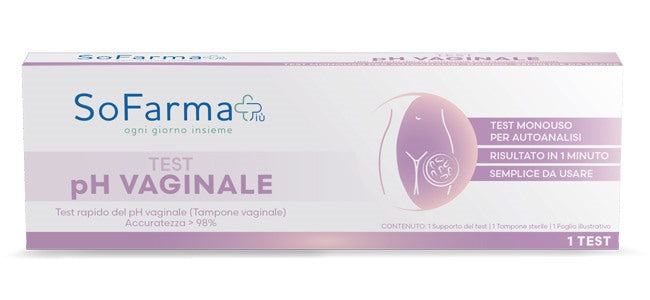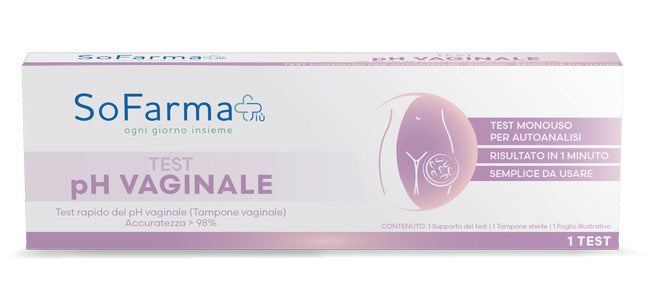Sofarmapiu' Vaginal Ph Rapid Self-Test Sofarmapiu'
Sold out
48% off
€5,19
€9,90
Unit price
/
Unavailable
Tax included, shipping and discounts calculated at checkout.
SOFARMAPIU | SKU:
987273822
Notify me when it's back in stock!
Write us your email, you will be notified when this product becomes available again!
Sofarmapiu' Vaginal Ph Rapid Self-Test Sofarmapiu' is backordered and will ship as soon as it is back in stock.
Shipping Costs and Times
Shipping Costs and Times
- Order fulfillment within 24 hours and delivery within the following 48/72 hours.
- Shipping cost: always free for orders over €49.90, otherwise it costs €4.99.
Payments
Payments
Payment information is processed securely. We do not store credit card information or have access to your credit card information.
Returns and Refunds
Returns and Refunds
You can return and receive a refund for the item within 30 days. See full policy here.

Do you need help?
Our customer service is here to help you!
- Contact us by phone, email or WhatsApp, from Monday to Friday, from 9:00 to 20:00 .
- For common questions, such as tracking your order or checking its fulfillment status, you can count on our artificial intelligence , available 24/7 .
We are always at your side to offer you fast and effective support!
Description
Description
RAPID SELF-DIAGNOSTIC TEST VAGINAL PH SOFARMAPIU' SOFARMAPIU'
SoFarma
VAGINAL pH TEST
Description
Rapid test for the semi-quantitative detection of pH in female vaginal swabs, as an aid in the diagnosis of bacterial vaginosis.
How to use
Sample collection and preparation
The test can be performed using samples from female vaginal swabs.
Wash your hands before starting the test. Open the package, remove the swab from the pouch and do not touch the swab head (polyester head).
Separate the labia, leaving the vagina exposed. Gently insert the head of the swab into the vagina and press it lightly on one spot for about 10 seconds, once a length of about 5 cm has been inserted (about the length of an AA battery). It is important to leave the swab in the vagina for about 10 seconds in order to properly moisten the head of the swab with vaginal secretions. It is essential for the test to be evaluated that the swab is sufficiently moistened.
Remove the swab from the vagina to perform the test.
Running the test
Allow the test and swab to reach room temperature (15-30°C) before testing.
Remove the test cassette from the sealed pouch and use it within one hour. For best results, perform the test immediately after opening the pouch.
Place the test cassette on a clean, stable surface or hold it with your free hand. Rub the sample head on the pH reactive area of the test cassette at least 5 times, taking care to apply a sufficient amount of secretion.
Read the result immediately, while the measuring area is still wet. Compare the color of the pH measuring area with the color scale on the pouch and note the value on the scale closest to the color on the test. After evaluation, discard the used test and sample.
Reading the results
The results are obtained by visually comparing the pH measuring area with the color scale on the packaging.
- NORMAL RANGE: Vaginal pH levels between 3.8 and 4.4 are within the normal range. The indicator color is yellow-green.
- ABNORMAL RANGE: Vaginal pH levels above 4.4 or below 3.8 are outside the normal/healthy range. When the pH level is above 4.4, the color of the indicator is green-blue, when the pH levels are below 3.8, it is bright yellow.
Warnings
For in vitro self-diagnostic use only. Do not use after the expiry date.
Do not consume food or drink, or smoke in the specimen and kit handling area.
Used tests must be disposed of in accordance with local regulations.
Humidity and temperature can negatively affect results.
Do not use the test if the package is damaged.
Use each test holder only once.
Use only the swab provided with the kit.
Open the swab package only when you are ready to collect the sample.
Do not use this test within 72 hours of applying vaginal preparations such as birth control creams and vaginal medical products (antifungal drugs, vaginal suppositories, creams, gels, douches, etc.).
Do not use this test within 48 hours of having sexual intercourse.
Do not use this test within 5 days of the end of your menstrual cycle.
Some postmenopausal women may have a high vaginal pH and, as a result, may get an abnormal result on the rapid vaginal pH test even in the absence of a bacterial or parasitic infection.
Some circumstances (menstrual cycle, sexual intercourse, vaginal medical products) can temporarily alter the vaginal pH level and may lead to false results. Therefore, it is necessary to follow precautions when performing the test.
Do not shower or wash the affected area immediately before collecting the sample.
Please note that urine can cause a false test result.
Never start any therapy before discussing the test result with a doctor.
Improper use can cause hymen rupture in virgin women, as happens with the use of tampons.
This is not a test for sexually transmitted diseases, such as HIV, chlamydia, herpes, gonorrhea, or syphilis.
Conservation
Store in the sealed pouch at room temperature or in the refrigerator (2-30 °C). Do not freeze.
The test is stable until the expiration date printed on the sealed pouch. The test must remain in the sealed pouch until use.
Validity with intact packaging: 24 months.
Format
The kit contains:
- test cassette;
- sterile swab;
- package leaflet.
Bibliography
1. Hanna NF, Taylor-Robinson D, Kalodiki-Karamanoli M, Harris J r, McFadyen IR The relationship between vaginal pH and the microbiological status in vaginitis. British Journal of Obstetrics and Gynaecology, 1985, Vol.92 (12), pp.1267-71
2. Nakra Natasha A, Madan Pellett, Buckley Niall etc. Loss of Innate Host Defense Following Unprotected Vaginal Sex. The Journal of infectious diseases, 2016, Vol.213 (5), pp.840-7
3. Roy Subir, Caillouette James C, Faden Joel S, Roy Tapon, Ramos Diana E. Improving appropriate use of antifungal medications: the role of an over-the-counter vaginal pH self-test device. Infectious Diseases in Obstetrics and Gynecology, 2004, Vol.11 (4), pp.209-16
4. Panda Subrat, Das Ananya, Singh Ahanthem Santa, Pala Star. Vaginal pH: A marker for menopause. Journal of mid-life health, 2014, Vol.5 (1), pp.34-7.
5. Maloney C, Oliver M L. Effect of local conjugated estrogens on vaginal pH in elderly women. American Medical Directors Association. Journal, 2003, Vol.2 (2), pp.51-5
Cod. SF015
Rapid test for the semi-quantitative detection of pH in female vaginal swabs, as an aid in the diagnosis of bacterial vaginosis.
How to use
Sample collection and preparation
The test can be performed using samples from female vaginal swabs.
Wash your hands before starting the test. Open the package, remove the swab from the pouch and do not touch the swab head (polyester head).
Separate the labia, leaving the vagina exposed. Gently insert the head of the swab into the vagina and press it lightly on one spot for about 10 seconds, once a length of about 5 cm has been inserted (about the length of an AA battery). It is important to leave the swab in the vagina for about 10 seconds in order to properly moisten the head of the swab with vaginal secretions. It is essential for the test to be evaluated that the swab is sufficiently moistened.
Remove the swab from the vagina to perform the test.
Running the test
Allow the test and swab to reach room temperature (15-30°C) before testing.
Remove the test cassette from the sealed pouch and use it within one hour. For best results, perform the test immediately after opening the pouch.
Place the test cassette on a clean, stable surface or hold it with your free hand. Rub the sample head on the pH reactive area of the test cassette at least 5 times, taking care to apply a sufficient amount of secretion.
Read the result immediately, while the measuring area is still wet. Compare the color of the pH measuring area with the color scale on the pouch and note the value on the scale closest to the color on the test. After evaluation, discard the used test and sample.
Reading the results
The results are obtained by visually comparing the pH measuring area with the color scale on the packaging.
- NORMAL RANGE: Vaginal pH levels between 3.8 and 4.4 are within the normal range. The indicator color is yellow-green.
- ABNORMAL RANGE: Vaginal pH levels above 4.4 or below 3.8 are outside the normal/healthy range. When the pH level is above 4.4, the color of the indicator is green-blue, when the pH levels are below 3.8, it is bright yellow.
Warnings
For in vitro self-diagnostic use only. Do not use after the expiry date.
Do not consume food or drink, or smoke in the specimen and kit handling area.
Used tests must be disposed of in accordance with local regulations.
Humidity and temperature can negatively affect results.
Do not use the test if the package is damaged.
Use each test holder only once.
Use only the swab provided with the kit.
Open the swab package only when you are ready to collect the sample.
Do not use this test within 72 hours of applying vaginal preparations such as birth control creams and vaginal medical products (antifungal drugs, vaginal suppositories, creams, gels, douches, etc.).
Do not use this test within 48 hours of having sexual intercourse.
Do not use this test within 5 days of the end of your menstrual cycle.
Some postmenopausal women may have a high vaginal pH and, as a result, may get an abnormal result on the rapid vaginal pH test even in the absence of a bacterial or parasitic infection.
Some circumstances (menstrual cycle, sexual intercourse, vaginal medical products) can temporarily alter the vaginal pH level and may lead to false results. Therefore, it is necessary to follow precautions when performing the test.
Do not shower or wash the affected area immediately before collecting the sample.
Please note that urine can cause a false test result.
Never start any therapy before discussing the test result with a doctor.
Improper use can cause hymen rupture in virgin women, as happens with the use of tampons.
This is not a test for sexually transmitted diseases, such as HIV, chlamydia, herpes, gonorrhea, or syphilis.
Conservation
Store in the sealed pouch at room temperature or in the refrigerator (2-30 °C). Do not freeze.
The test is stable until the expiration date printed on the sealed pouch. The test must remain in the sealed pouch until use.
Validity with intact packaging: 24 months.
Format
The kit contains:
- test cassette;
- sterile swab;
- package leaflet.
Bibliography
1. Hanna NF, Taylor-Robinson D, Kalodiki-Karamanoli M, Harris J r, McFadyen IR The relationship between vaginal pH and the microbiological status in vaginitis. British Journal of Obstetrics and Gynaecology, 1985, Vol.92 (12), pp.1267-71
2. Nakra Natasha A, Madan Pellett, Buckley Niall etc. Loss of Innate Host Defense Following Unprotected Vaginal Sex. The Journal of infectious diseases, 2016, Vol.213 (5), pp.840-7
3. Roy Subir, Caillouette James C, Faden Joel S, Roy Tapon, Ramos Diana E. Improving appropriate use of antifungal medications: the role of an over-the-counter vaginal pH self-test device. Infectious Diseases in Obstetrics and Gynecology, 2004, Vol.11 (4), pp.209-16
4. Panda Subrat, Das Ananya, Singh Ahanthem Santa, Pala Star. Vaginal pH: A marker for menopause. Journal of mid-life health, 2014, Vol.5 (1), pp.34-7.
5. Maloney C, Oliver M L. Effect of local conjugated estrogens on vaginal pH in elderly women. American Medical Directors Association. Journal, 2003, Vol.2 (2), pp.51-5
Cod. SF015


